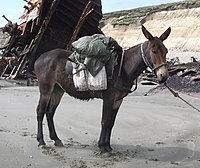
Photo from wikipedia
Interspecific and intergeneric hybridization within the Festuca-Lolium complex is frequently used in forage plant breeding. However, little is known about the natural occurrence and competitiveness of such hybrids. We collected… Click to show full abstract
Interspecific and intergeneric hybridization within the Festuca-Lolium complex is frequently used in forage plant breeding. However, little is known about the natural occurrence and competitiveness of such hybrids. We collected naturally formed hybrids between Festuca apennina, Festuca pratensis, and Lolium perenne in different habitats of Switzerland and the British Isles and studied their origin, the ease of their spontaneous formation, and their competitiveness with parental species. A special attention was paid to the largely sterile triploid forms and their rare sexual progeny. The triploid hybrid F. apennina × F. pratensis proved to be widespread and often highly competitive in Swiss permanent pastures. The majority of these hybrids originated from F. apennina as the seed parent although little or no F. apennina grew nearby. In an experimental setting with ample F. pratensis pollen provided by neighbouring plants, up to 20 % of seeds from open pollinated F. apennina plants were interspecific hybrids; among seeds collected in natural habitats, only 0.35 % were hybrids. At an experimental site at 1 000 m altitude, these triploid hybrids grew much more vigorously than corresponding tetraploid pure F. apennina, confirming their great competitiveness at such altitudes in permanent grasslands. The triploid hybrids were only marginally fertile suggesting that vegetative propagation by rhizomes is the cause of their competitive success in grassland. Moreover, triploid progeny retained the chromosome constitution of their mother plants indicating the possibility of apomixis. Natural triploid F. pratensis × L. perenne hybrids were partially female fertile (a seed set of 0.1 % or less) whereas diploid hybrids did not produce any viable seeds. Progenies of these triploids showed considerable chromosome alterations, such as loss of a genome or recombination due to homoeologous pairing, and only rarely the chromosome constitution of the triploid mother plant was retained. It was concluded that natural triploid interspecific hybrids could expand the range of their progenitor species and might function as bridges transferring genes between them.
Journal Title: Biologia Plantarum
Year Published: 2020
Link to full text (if available)
Share on Social Media: Sign Up to like & get
recommendations!